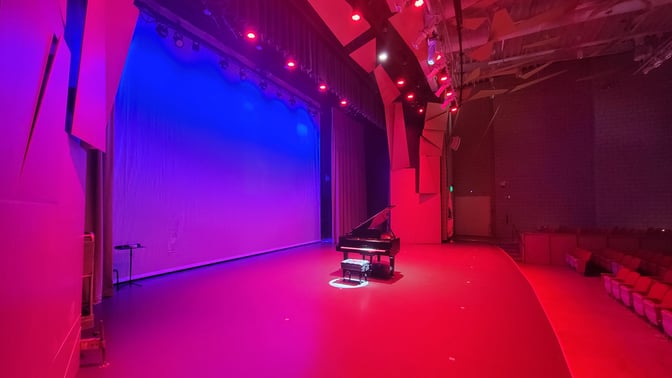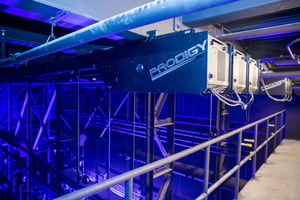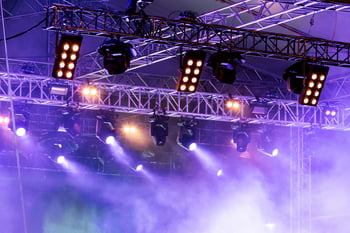Share this
How Theatrical Rigging Creates Customized Venues and Productions
by PORT on Oct 31, 2022 8:00:00 AM

Whether you’re working on a professional stage show or are a student apprenticing for your high school musical, you’ve likely used rigging. Counterweight rigging, motorized rigging, and dead-hung rigging include components that bring many different aspects of theater to life, whether it’s moving or hanging scenery, lights, or curtains.
The acrobats in Cirque du Soleil can’t “fly” across the stage without rigging. And without rigging to enable quick changes, most productions wouldn’t have the flexibility to depict varied scenery.
Each type of theater rigging has pros and cons and specific uses.
Dead hung rigging
.jpg?width=300&height=175&name=Dead%20Hung%20Rigging%20(1).jpg) This type of rigging is usually used in theaters with low ceilings and includes pipes (battens) or tracks that permanently hang from the ceiling. Dead-hung rigging is not designed to lower equipment to the stage floor. To perform maintenance or change the equipment, a stagehand has to go up to the batten instead of bringing the batten down for adjustments.
This type of rigging is usually used in theaters with low ceilings and includes pipes (battens) or tracks that permanently hang from the ceiling. Dead-hung rigging is not designed to lower equipment to the stage floor. To perform maintenance or change the equipment, a stagehand has to go up to the batten instead of bringing the batten down for adjustments.
Counterweight rigging
 Counterweight rigging systems employ simple physics principles to use balanced weights, pulleys, and ropes to bring many aspects of theater to life. Counterweights – equal amounts of steel weights located backstage – counterbalance the load. Stage workers can easily raise and lower production elements using counterweight rigging systems. When balanced, one tech can move and maintain control over a significant amount of equipment with little effort. However, an error during loading can cause it to be dangerously unbalanced.
Counterweight rigging systems employ simple physics principles to use balanced weights, pulleys, and ropes to bring many aspects of theater to life. Counterweights – equal amounts of steel weights located backstage – counterbalance the load. Stage workers can easily raise and lower production elements using counterweight rigging systems. When balanced, one tech can move and maintain control over a significant amount of equipment with little effort. However, an error during loading can cause it to be dangerously unbalanced.
Motorized rigging
While more expensive than counterweighted systems, motorized rigging requires less stage space and less structural steel. Most motorized, automated rigging sets used in theater productions are “dead haul” sets. This means that the motor lifts the entire weight of the equipment, without counterbalancing, which eliminates the safety concerns that come with improperly balanced sets and handling heavy weights.
 In addition, with automated rigging, stagehands can physically or digitally lock the controls so an unauthorized operator can’t use them. Motorized rigging systems are excellent when you need to move heavy, multi-element sets quickly and accurately. They allow you to program these movements for precise cues, timing, and consistent performances.
In addition, with automated rigging, stagehands can physically or digitally lock the controls so an unauthorized operator can’t use them. Motorized rigging systems are excellent when you need to move heavy, multi-element sets quickly and accurately. They allow you to program these movements for precise cues, timing, and consistent performances.
At PORT, we primarily use ETC Prodigy motorized hoists because they are affordable and user-friendly due to their easy-to-read displays and simple controls. Prodigy motorized hoists are lightweight and use compression tube technology, which allows us to connect them to a structure with fewer brackets. That also means you can use them to retrofit spaces that aren’t designed for a stage machinery system.
PORT – Customized theatrical rigging
In business since 1985, PORT designs and installs customized theatrical rigging for every type of venue. When you work with our highly skilled team, you’ll be confident we will construct and install everything correctly and safely. In addition to theatrical rigging and lighting, our services include:

Read about our recent project installing ETC Prodigy motorized hoists at Phillips Exeter Academy’s Goel Center for Theater and Dance. Want to learn more about how we can enhance your venue? Contact us today!
Share this
- Event Production (25)
- Event Lighting (20)
- Event Planning (19)
- Lighting Control Systems (15)
- Theatrical Lighting (15)
- event lighting services (15)
- Architectural Lighting (13)
- Lighting Effects (11)
- Architectural Lighting Design (10)
- Theatrical rigging (10)
- Architectural Lighting Installation (7)
- LED Light (7)
- Wedding Lighting (7)
- Theatrical Installations (6)
- Theatrical Lighting Installation (6)
- Installation (5)
- Rigging (5)
- Stage Lighting (5)
- Event Drape (4)
- Lighting Integration Services (4)
- Rigging Inspection (4)
- Design (3)
- Production Design (3)
- Technical Production Management (3)
- Theatrical Lighting Design (3)
- Virtual Content (3)
- Audio-Visual (2)
- Concert Lighting (2)
- Corporate Production Services (2)
- Lighting History (2)
- Sports Lighting (2)
- 3D Rendering (1)
- Bridge Lighting (1)
- Commercial Lighting (1)
- Logistics (1)
- Operations (1)
- Pre-Visualization (1)
- Virtual Event (1)
- April 2025 (1)
- March 2025 (2)
- January 2025 (1)
- December 2024 (1)
- November 2024 (1)
- October 2024 (1)
- September 2024 (1)
- August 2024 (1)
- May 2024 (1)
- April 2024 (1)
- March 2024 (2)
- February 2024 (2)
- January 2024 (3)
- December 2023 (3)
- November 2023 (6)
- October 2023 (1)
- September 2023 (1)
- July 2023 (1)
- March 2023 (1)
- January 2023 (4)
- December 2022 (3)
- November 2022 (4)
- October 2022 (4)
- September 2022 (4)
- August 2022 (2)
- July 2022 (3)
- June 2022 (13)


No Comments Yet
Let us know what you think